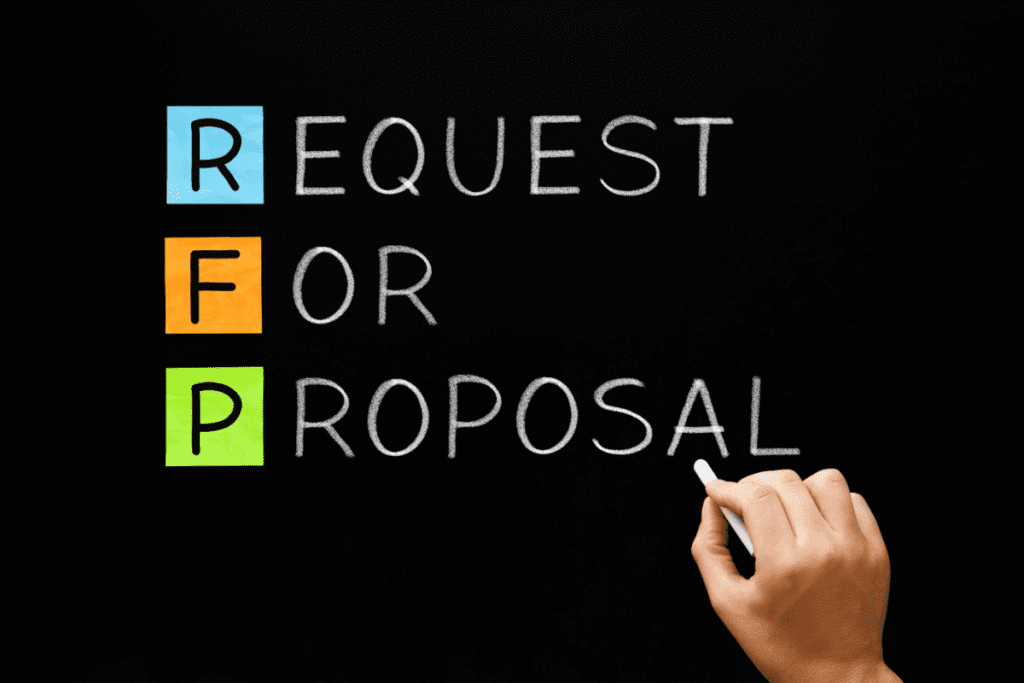RFP Template Handbook: What Are RFPs (Request For Proposals)
Struggling to organize your project requirements and find the best vendors? Businesses globally utilize Request for Proposals (RFPs) as a key tool in their procurement process. Wondering just what are RFPs?
What are RFPs? RFPs, or a Request for Proposal, is both a Strategic Sourcing process in Procurement and a corresponding document to identify the best-suited goods or services to award a contract. The RFP includes the specifications of the business requirements, vendor participation guidelines and the RFP timeline.
This blog provides you step-by-step guidelines on writing an efficient RFP that attracts competent vendors and ensures optimal results for your projects.
Key Takeaways
- RFPs (Request for Proposals) are vital business documents that outline project requirements and solicit proposals from potential vendors.
- An effective RFP includes key components such as project goals, submission deadlines, selection criteria, and vendor demo requirements.
- Benefits of using an RFP include a structured procurement process, accurate and competitive bids, tailored proposals aligned with your objectives, and transparency in the selection process.
What are RFPs (Request for Proposals)?
RFPs, also known as Request for Proposals, are essential documents in the business world. They serve the purpose of outlining project requirements and soliciting proposals from potential vendors or service providers.
RFPs consist of several key components, such as project goals, selection criteria, and submission deadlines. By using an RFP, businesses can ensure a fair and efficient evaluation process while providing clear guidelines to prospective bidders.
Definition and purpose of RFPs
An RFP, or Request for Proposal, is a vital business document that introduces a project and seeks bids from appropriate vendors to complete it. The primary purpose of an RFP is to list out all the specific needs and requirements of a project in detail.
This assists businesses in formulating their proposals effectively. Not only does an RFP streamline the process of finding apt contractors, but it also ensures businesses attract qualified candidates best suited for their projects.
An organization seeking potential partners typically drafts this essential tool before disseminating it to various vendors who then furnish information about their company’s capabilities in response.
Key components of an RFP
Composing an effective RFP involves several vital elements. Each of these components plays a crucial role in providing potential vendors with the necessary information to submit a thorough and competitive proposal.
1. Introduction: This sets the stage for your project and gives potential vendors an overview of your organization.
2. Project Goals and Scope: Here you describe what you aim to achieve and outline what the project entails, ensuring bidders understand the work needed.
3. Proposal Format and Requirements: This section outlines how vendors should structure their proposals, including details like page length, font size, file type, or specific sections they need to include.
4. Submission Deadlines: It’s essential to provide clear dates for when proposals must be submitted. You might also include other key dates such as question period end date or final decision date.
5. Selection Criteria: The criteria on which you’ll be assessing each vendor’s proposal should be clearly outlined here.
6. Budget: If is typical to have an approved budget before going for RFP. While mentioning the dollar amount is not one of our best practices, it is a best practice in the spirit of fair-play and professionalism to disclose if you have an approved budget in your RFP. Vendors commit resources during an RFP event and they want to know if there is an approved budget and actual contract they can win.
7. Vendor Demo Requirements: If you want prospective suppliers to demo their product or service, this section explains when and how they should carry out those demos.
8. Contacts for Further Information: Lastly, provide contact information so interested vendors can seek any required clarity before submitting their proposal.
Benefits of using an RFP
RFPs, or Requests for Proposals, offer invaluable advantages for your business. Issuing an RFP brings structure and clarity to the procurement process. Each potential vendor knows exactly what you need, from deadlines to deliverables.
The result? You receive more accurate and competitive bids. Sharing your vision of the project through RFPs encourages participating vendors to tailor their proposals specifically to your needs, ensuring closer alignment with your objectives.
Moreover, this documentation allows you a comprehensive view of all proposals side by side, making it easier for you to compare and choose the best fit for your enterprise. No wonder then that many industries including government contracting utilize RFPs frequently!
Through this methodical approach using RPFs not only you get transparency in the selection process but also witness smooth execution of projects thus bringing efficiency in business operations.
How to Effectively Write an RFP?
To write an effective proposal that meets your needs, you will need the project details. This start in the RFP Discovery Phase by clearly identifying the project goals and scope. You will need to make sure the RFP is clear before you submit a proposal to the vendor.
Have a well defined scope statement, detailed guidelines and comprehensive instructions to ensure vendors understand what is required. Outline the selection criteria and evaluation process to make it easier for vendors to submit proposals.
Set specific deadlines and submission dates to keep the process on track. Address any potential roadblocks or concerns upfront to avoid misunderstandings.
Identifying project goals and scope
To write an effective RFP, it is crucial to begin by identifying the project goals and scope. This involves clearly understanding what the project aims to achieve and its specific boundaries.
By defining the objectives, deliverables, and limitations upfront, you set a clear direction for potential contractors. This step ensures that all proposals received will be aligned with your vision and requirements.
It helps streamline the evaluation process as you can easily assess whether each proposal meets the established goals and fits within the defined scope of work. Identifying project goals and scope provides a solid foundation for writing a comprehensive RFP that attracts qualified contractors who understand your specific needs.
Providing clear guidelines and instructions
When writing an RFP, it is crucial to provide clear guidelines and instructions. This ensures that potential vendors understand the requirements and expectations of the project. Here are some key points to consider:
1. Clearly state the goals and objectives of the project: Provide a concise description of what you want to achieve with this project.
2. Outline the scope of work: Define the specific tasks, deliverables, and timelines associated with the project.
3. Specify technical requirements: Clearly state any technical specifications or qualifications that vendors must meet in order to be considered for the project.
4. Provide a submission format: Clearly outline how vendors should structure their proposals and what information they need to include.
5. Include evaluation criteria: Communicate how you will evaluate proposals and what factors will be taken into consideration when selecting a vendor.
6. Address questions and clarifications: Let vendors know how they can ask questions or seek clarification about the RFP, ensuring transparency and fairness in the selection process.
7. Set deadlines: Clearly specify the deadline for submitting proposals, as well as any other important dates related to the evaluation process.
Outlining selection criteria and evaluation process
Outlining selection criteria and evaluation process is an important step in writing an effective RFP. This helps businesses in finding the most qualified contractors for their project. Here are some key points to consider:
1. Clearly define the selection criteria: Outline the specific qualifications, expertise, and experience that you are looking for in a contractor. This could include technical skills, industry experience, relevant certifications, or previous work examples.
2. Establish evaluation methods: Determine how you will evaluate the proposals received. This could involve scoring criteria based on different factors such as cost, quality, timeline, or innovation. Clearly communicate the weightage given to each criterion.
3. Provide guidelines for proposal submission: Specify the format and structure that contractors should follow when submitting their proposals. This ensures consistency and makes it easier to compare and evaluate different submissions.
4. Set expectations for deliverables: Clearly state what you expect from the contractors in terms of project deliverables, timelines, milestones, and reporting requirements. This helps potential vendors understand your needs and capabilities.
5. Include any additional evaluation considerations: If there are any specific considerations or requirements unique to your project, make sure to include them in this section of the RFP.
Setting deadlines and submission dates
Setting deadlines and submission dates is a crucial step in the RFP process. By specifying clear timelines, you ensure that potential vendors have enough time to prepare their proposals and submit them before the deadline.
This allows you to evaluate all proposals fairly and make an informed decision. Deadlines also create a sense of urgency for vendors, encouraging them to prioritize your project and submit their best possible proposal.
So, when setting deadlines and submission dates in your RFP, consider the time it takes for both preparation and evaluation, giving everyone involved enough time to complete the process efficiently.
Addressing possible roadblocks and concerns
To ensure a smooth procurement process, it is important to address any potential roadblocks and concerns that may arise. This includes anticipating challenges such as budget constraints, technical limitations, or conflicting stakeholder priorities.
By acknowledging these potential issues upfront in the RFP, you allow vendors to provide solutions and proposals that can mitigate these risks. Open communication and transparency throughout the process will help build trust between all parties involved and increase the chances of finding the best-fit contractor for your project.
What is included in RFP Requirement Gathering?
An RFP typically has a Requirements Matrix. This is typically a list of detailed requirements in an MS Excel or similar style spreadsheet. Higher level Functional and Technical Requirements are gathered and included in an RFP package to provide as much transparency into the expectations of the request.
These detailed requirements can be sent and the vendors respond with the RFP Document and constitute the RFP Package. This “Package” typically contains all of the requirements for the bidders to review.
- The RFP Matrix is a more straightforward communication style in asking if the bidder has a solution to the requirement.
- The RFP Document would communicate requirements that require more of an explanation of “how” the solution the requirement, or requests for documentation like design specs or information security documents (e.g. SOC 2 or Security Questionnaires).
You can read a more detailed discussion on RFP Requirement Gathering Best Practices “How to Conduct RFP Discovery Effectively: Questions to Ask in the Request for Proposal / RFP Process”.
 What are some Tips to Include in an RFP?
What are some Tips to Include in an RFP?
When writing an RFP, consider collaborating with stakeholders to gather their insights and expertise. Create standardized templates and sections to streamline the process. Additionally, you may want to consider a multi-step process for evaluating proposals.
Prioritize transparency and open communication throughout the entire RFP process. Finally, customize and optimize your template to ensure it aligns with your specific project goals and requirements.
Collaborating with stakeholders
Collaborating with stakeholders is essential when writing an RFP (Request for Proposal). By involving key stakeholders, such as project managers and non procurement business people, you can gather valuable insights and perspectives to ensure that the RFP accurately captures the project’s goals and requirements.
Additionally, collaborating with stakeholders helps build consensus and alignment among team members, increasing the chances of selecting a qualified contractor who can successfully complete the project.
Through open communication and collaboration, you can harness the expertise of your stakeholders to create a comprehensive RFP that attracts the right vendors and sets your project up for success.
Creating standardized templates and sections
Creating standardized templates and sections is essential when writing an RFP. It helps ensure consistency and clarity throughout the document. Not only does this make it easier for vendors to understand and respond to your requirements, it also adds professionalism to the bidding process.
Here are some tips:
1. Use a standardized format: Choose a format that includes all the necessary sections and information. This makes it easier for vendors to navigate the document and find what they need.
2. Clearly label each section: Use clear headings for each section of the RFP, such as “Introduction,” “Project Scope,” “Timeline,” etc. This helps vendors quickly locate specific information.
3. Provide templates for responses: Create predefined sections or templates for vendors to fill in their responses, such as company background, pricing details, response worksheets, project approach, etc. This ensures consistency in the information provided by different vendors.
Tip: Remember, you will need to score and compare their responses.
4. Include instructions and examples: Alongside each section or template, provide clear instructions on what you expect from vendors in their responses. You can also include examples or sample answers to help vendors better understand your expectations.
5. Use consistent language and terminology: Maintain consistency in language and terminology used throughout the RFP to avoid confusion. Ensure that definitions and acronyms are clearly explained if used.
6. Keep formatting consistent: Use consistent fonts, font sizes, bullet points, numbering systems, etc., throughout the document. This gives your RFP a professional appearance and makes it easier to read.
Considering a multi-step process
Writing an RFP involves considering a multi-step process. This helps ensure that all necessary information is gathered and the selection criteria are clearly defined.
- Identify project goals and scope, which will guide the rest of the RFP document.
- Provide clear guidelines and instructions for vendors to follow when submitting their proposals. Outline the selection criteria and evaluation process so that both parties understand how decisions will be made.
- Set deadlines and submission dates to keep the process on track. Finally, address any possible roadblocks or concerns upfront to avoid delays later on. By following this multi-step approach, you can create an effective RFP that attracts qualified contractors and leads to successful project outcomes.
Prioritizing transparency and communication
Transparency and communication are crucial elements when it comes to writing a successful RFP. By prioritizing transparency, you ensure that all the information regarding the project is clearly laid out for potential vendors.
This includes providing detailed requirements, project goals, and evaluation criteria. Transparency also means being open about any concerns or roadblocks that may arise during the process.
Additionally, effective communication plays a vital role in ensuring that all parties involved are on the same page. Clearly outline guidelines and instructions for submitting proposals, set deadlines and submission dates, and establish channels for addressing questions or concerns.
Regularly communicate with stakeholders throughout the process to keep them informed and engaged.
Customizing and optimizing your template
Customizing and optimizing your template is an essential step in maximizing the effectiveness of your RFP (Request for Proposal) process. By tailoring the template to fit your specific project requirements, you can ensure that all necessary information is included and easily understood by potential vendors.
Consider adding sections or questions that address unique aspects of your project or industry, while removing any irrelevant or redundant content. Additionally, optimizing your template involves streamlining the language and formatting to enhance clarity and readability.
By taking the time to customize and optimize your template, you can greatly improve the quality of proposals received and increase the chances of finding the right partner for your project.
FAQs
1. What is an RFP (Request For Proposals)?
An RFP is a formal document that organizations use to invite potential vendors or service providers to submit proposals for a specific project or problem-solving solution.
2. Why do organizations use RFPs?
Organizations use RFPs to ensure transparency and fairness in the procurement process, as well as to gather detailed information about potential vendors’ capabilities, pricing, and proposed solutions.
3. How can I respond to an RFP?
To respond to an RFP, thoroughly review the requirements outlined in the document, prepare a written proposal addressing each requirement, and submit it within the designated deadline specified in the RFP.
4. Are there any risks associated with responding to an RFP?
While there are no inherent risks associated with responding to an RFP, it’s important for vendors to carefully evaluate whether they have the necessary resources and expertise before committing time and effort into preparing a proposal.
5. What is an RFQ (Request For Quotation)?
An RFQ is a document or a process used to solicit price quotes from potential suppliers or vendors. It is typically used when the buying organization has a specific product or service requirement and wants to compare prices and terms from multiple suppliers before making a purchasing decision
Conclusion
Understanding RFPs (Request for Proposals) is crucial for businesses looking to select the right vendor partner for their projects. By utilizing an effective RFP, companies can outline their project requirements and attract qualified bidders.
Writing a comprehensive RFP can streamline the selection process and ultimately lead to successful partnerships.
If you liked this article, remember to subscribe to MiamiCloud.com. Connect. Learn. Innovate.







